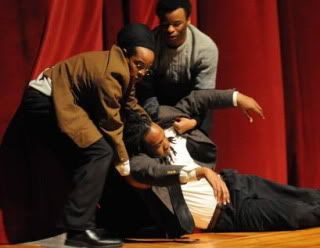Remembering '68: Students Re-enact Orangeburg Massacre
 Via the Times & Democrat:
Via the Times & Democrat:
The first live reenactment of the Orangeburg Massacre included a mix of humor, sorrow and passion, which students say helped tell the stories of three slain students whose one purpose was to promote justice and equality.
Produced by the Henderson-Davis Players, the original stage play “Taking a Stand” debuted Thursday night in the Martin Luther King Auditorium on the campus of South Carolina State University. Its purpose was to provide a reenactment of the events that led up to what has become known as the Orangeburg Massacre, which occurred on Feb. 8, 1968.
Two days earlier, several students were hospitalized during a protest rally against the segregated All Star Bowling Lanes - black students had tried to bowl there and were refused, then tensions rose and a fight broke out between the students and the city police. The agitation continued into the week. On the 8th, the students constructed a bonfire. When police and firemen were called to disperse the crowd and douse the fire, a police officer was hit by a piece of a banister as students retreated. Minutes later scores of cops lined up on the edge of campus, armed with pistols, rifles, and shotguns. Claiming later that they heard gunfire, police shot into the crowd, killing students Henry Smith, Samuel Hammond and Delano Middleton. The play's site tells us:
As students began returning to the front to watch their bonfire go out, a patrolman suddenly squeezed several rounds from his carbine into the air—apparently intended as warning shots. As other officers began firing, students fled in panic or dived for cover, many getting shot in their backs and sides and even the soles of their feet.
The next day, the Governor blamed outside "Black Power agitators." To add insult to injury, the nine police officers who shot into the crowd were cleared of all charges - the only person to serve jailtime was SNCC activist Cleveland Sellers, who was convicted for inciting the riot itself. (Sellers was pardoned 25 years later; in 2008 he was tapped to be President of Voorhees College, an HBC.)
Just about every institution of higher ed in this country has a history of resistance. It's often not as graphic as the iconic '60s campus actions we think of (and it's often meticulously hidden by administrators) but I'd argue it's just as important for those organizing on the ground here and now. Keeping in touch with your own school's history can help to inspire and motivate students. Students at SCSU are using dramatic re-enactments to bring the conflicts of the '60s back to life for a new generation:
Timothy Hughes, a 20-year-old junior elementary education major at S.C. State, said the play’s producers and actors did a “great job” of getting students to understand what the Orangeburg Massacre was about as well as its importance and the seriousness of the event.
“As far as civil rights, I think it was really a great opportunity to expose a lot of young minds to it. They probably don’t realize how important it is and what the people in the play fought for. But coming after them, I really am proud and respect the fact that Middleton, Hammond and Smith fought for a great cause. And I’m so proud of my peers and other students in the play. They did an excellent job,” Hughes said. “I’m real proud.”
Nicholas Darien, a 20-year-old junior business management major at the university, said the play drew heavily on his emotions and did a good job informing the public about what happened during the Orangeburg Massacre.
“A lot of people still don’t know what happened. The play was very emotional. I really felt the play. It was really exciting for me, and it was a great experience for me to come and see it. As the title says, take a stand and be a believer. Just stand strong and you’ll overcome.”
So ask your professors. Dig up old student newspapers and yearbooks. Especially in the wake of the passing of radical historian Howard Zinn, let's take the time to find the voices of resistance and hope who spoke before us - and listen to what they say.